26th November
I heard last week of another ‘control’ of one of the Longham birds. Not a great movement but good to hear of it again – details below. Strictly it shouldn’t be a control as it was caught less than 5km from the ringing location – so officially it is a local re-trap!
Chaffinch
S283188
N 4F 23/05/17 RHP Longham Lakes East (4), Dorset
C 4F 19/11/17 TE/KL Arrowsmith Road, Canford Heath, Dorset (4.5 km, W, 180 days)
22nd November
Some decent totals of individual species today, e.g. 137 Lapwings, 124 Mute Swans and 61 Gadwall across both lakes combined. Around 20 each of Little Grebe and Shoveler (Carl Wilcox.)
18th November
The place looked wonderful even on a dull grey day as today. I looked through the gulls hoping to find something special but the best I could find was Common Gull. Plenty of Coots, Wigeon and Shoveler, a few Teal and Pochard. 4 Snipe were feeding on the large island in full view (Martin Wood.)
17th November
The water level has dropped, exposing the beach area of the large island and shoreline, which was being used by 3 Little Egrets, while Snipe were on the island . Lots of Wigeon still about and Gadwall, 74 Lapwings resting on the mat of weed. A few Shoveler and a couple of Pochard (Martin Wood.)
5th November
A nice afternoon, with male Kestrel seen several times, 3 Buzzard and a Sparrowhawk low over the lake. 80 Lapwings were counted before being put by canoeists , 1 Common Gull in with lots of Black-headed Gulls and a few Herring Gulls (Martin Wood.)
3rd November
The lake was stacked with birds, mainly Coots and Mute Swans, with plenty of Wigeon, a few Shoveler and a small number of Teal. 100 Lapwings were resting on the mat of weed. What did surprise me, though, was the number of Moorhens – I counted 9 birds never seen so many round the lakes before. The male Kestrel was in a small bush on the west side of the lake. In the far distance over by the farm there were two Egrets (think they were Little Egrets) roosting in a tree with crows for company (Martin Wood.)
Little going regards ringing from 3.30pm, an adult female Blackbird, an adult Robin, a Goldcrest and a re-trap Chiffchaff. The latter was a bird I ringed on 5th December last year so nice to see it is still around (Roger Peart.)
2nd November
Ringing very quiet today – only 4 new birds: 2 Goldcrests, 1 Great Tit and 1 Green Woodpecker. Also 1 re-trap, a Great Tit first ringed October 2015 (Roger Peart.)
31st October
The best bird today was a Black Redstart late morning behind the pumping station at the south lake hopping around on the solar panels (Matt Bell.) Also 1 Black-tailed Godwit (Darren Hughes).
Ringing produced only 25 new birds – a big drop from yesterday. 8 Goldcrest, 6 Long-tailed Tits, 5 Chiffchaffs, 2 Firecrests and one each of Redwing, Song Thrush, Wren, Great Tit. The 4 re-traps were 2 Long-tailed Tit, 1 Great Tit and 1 Blue Tit. The latter was first ringed at the end of May 2016 when it was aged as in its second year. The other re-traps were all from this summer.
Amazingly I have had news today of the control Chiffchaff I caught yesterday. It travelled a long way (almost 770km) in 30 days, from the Deer Park Forest Croft, in the Scottish Highlands.
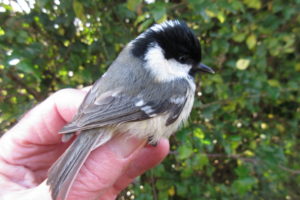
Coal Tit, Longham Lakes, Dorset 30/10/2017 (Roger Peart)
30th October
It was a good morning’s ringing session today. I caught 45 new birds and 4 re-traps plus a control Chiffchaff [a bird previously ringed somewhere else]. Almost half of the new birds were Goldcrests (22) and there were 4 Redwings, 4 Chiffchaffs, 3 Wrens, 2 each of Blue Tit, Great Tit and Song Thrush, and one each of Robin, Blackbird, Dunnock, Bullfinch (female), a Firecrest and, a new ringing record for Longham – a Coal Tit [and a rare bird here overall.] (Roger Peart).
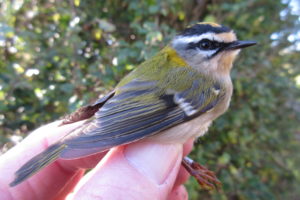
Firecrest, Longham Lakes, Dorset 30/10/2017 (Roger Peart)
Meanwhile, around the site generally there was a decent range of birds, including a Water Rail showing well on the smaller island in Longham Reservoir South, plus Stonechat on Hampreston Fields, and counts including 80 Mute Swans and 11 Lapwings. There were also 3 Red Admirals and a large blue dragonfly (of some sort). (Trevor Wilkinson). There appears also to be small roost of Magpies in the bushes in the south-east corner, at least 6 birds.
29th October
Pochard numbers have increased to 10 birds (Ron Poulter).
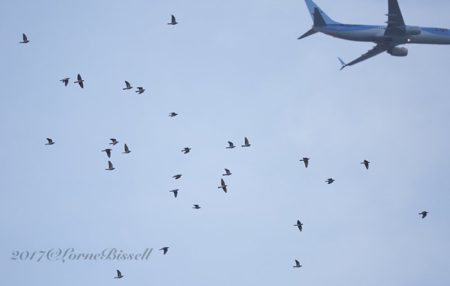
Woodpigeons, Longham Lakes 28/10/2017 (Lorne Bissell)
28th October
Today’s visible migration was dominated by Wood Pigeons, with 2200 of them moving south-west between 07.55 and 08.35. This is the highest count at Longham by far, and was, at times a good spectacle. Other moving birds included 15 Redpolls (it was a good day for these county-wide), 5 Reed Buntings, a few Skylarks, maybe 30 Redwings/Song Thrushes and several other species that may just have been flying around: 5 Linnets, 3 Grey Wagtails, 100 Starlings and a few Bullfinches and Siskins. In the early morning the Great Egret was settled on a tree by Longham Reservoir North but soon flew off north, while there was also 1 Dunlin, 2 Snipe, 1 Mediterranean Gull, 3 Common Gulls and the 2 Bearded Tits were still along the east bank (Dominic Couzens, Lorne Bissell.)
Meanwhile, it turns out that the Lesser Scaup has disgraced itself by moving to Blashford Lakes.
27th October
A classic October day. It would have been good anywhere, but here on this inland patch it was exceptional. Having said that, the Lesser Scaup proved to be a party pooper and wasn’t seen at all.
Longham is never really good for visible migration, but at least it has now tapped into the countrywide Hawfinch extravaganza, with one low over the south-eastern corner (the Settling Marsh) at 07.55, calling loudly on its way north. Thereafter there were a few Redwings and Song Thrushes over west, plus a small finch passage that included the first Redpolls of the year, a singleton and a flock of three. Reed Buntings, Linnets, Chaffinches and Meadow Pipits were also on the move in very small numbers, and Wood Pigeons in a more significant movement, certainly in the 100s. Most surprisingly, during this early flush of birds a Great Egret flew fairly high to the north at 08.37. Meanwhile, the Starling roost was terrorised by 2 different Sparrowhawks, which kept on calling loudly and seemingly cowed the birds into leaving very late; at least one Starling never made it out. A little later on a late Swallow turned up, the odd Skylark flew over and so did 2 Ravens.
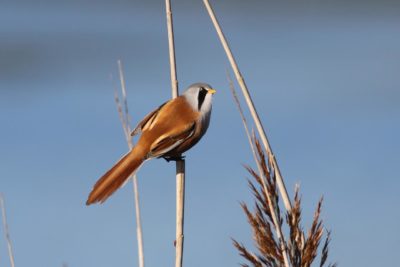
Bearded Tit (male), Longham Lakes, Dorset, 27/10/2017 (Paul Wilkins).
A big feature of the morning was the amazing entertainment provided by the Bearded Tits on the eastern shore of Longham Reservoir South. One pair was showing astoundingly well, and regularly “High-flying”, taking to the air, circling and then dropping down again, like a stone. Many birders got great views of this delightful autumnal behaviour.
By 11am I was beginning to realise that I had seen a lot of birds and, when I tallied them, it came to an equal of the previous Longham Lakes day record, 67 species – and no Collared Dove yet. A quick change of work plans meant that I made a quick trip to Emily’s Wood, where a flock of Siskins and a single Treecreeper brought me to 69. And now the magical 70 would be easy, with a Collared Dove somewhere on a roof on the houses along Ringwood Road. Half an hour later it became clear that these doves were enjoying an awayday somewhere else. In some desperation I decided to return to the lakeshore to check out the roofs from there. But on the way, at the end of the short private road, a small flock of Passerines contained a fabulous Firecrest. This 70th species of the day was also my very first for Longham Lakes – what a way to reach the milestone.
Apart from Collared Dove, I also missed the following species that were probably present on-site: Nuthatch, Kestrel, Peregrine, Snipe, Great bb Gull, Med Gull, Tawny Owl, Stonechat and perhaps Yellow-browed Warbler. Longham may well have played host to 80 species today.
Matt Bell was also out and about and managed 65 species, which is also seriously good, especially since he doesn’t have access to the private sections of the site. He did see a Collared Dove!
In addition to all this, Trevor Thorpe saw an Otter loping along the fence-line in Hampreston Fields, heading for the stream.
26th October
The Lesser Scaup was still around for the whole day, settling on Longham Reservoir North in the afternoon.
Even after 15 years of watching, a local patch can still surprise you. This morning I got on site before sunrise and was astonished to discover a Starling roost in the bushes next to the south-western tip of Longham Reservoir South – the site’s very own murmuration. The birds, 500-1000 individuals, were making quite a din. The Starlings’ departure from a roost is always worth watching and today’s was no exception. The birds sang loudly while it was still dark, but every so often they suddenly went quiet (apparently these silences average three minutes apart). As it gets light, the singing birds get restless and, during these sudden silences, birds shuffle about and some depart. This morning, since it was a small roost, they actually all departed in one surge, individuals going off low in all directions. It was fabulous. If the roost builds up this autumn, it is going to be quite a treat.
Who knows what flew over while I was watching the Starlings? – several Lapland Buntings and Olive-backed Pipits no doubt. Or at least Hawfinches. But no, overhead passage was very light, with a few Meadow Pipits, Redwings, Song Thrushes, Siskins and Linnets. Elsewhere there was at least 1 Bearded Tit along the eastern side, 2 Black-tailed Godwits were on the floating weed and, at one point, a small flock of Passerines on the path south of the Study Centre contained 2 Meadow Pipits, 2 Linnets, 3 Chaffinches and 2 Song Thrushes. There are loads of birds about (Dominic Couzens.)
25th October
The Lesser Scaup is still present and there are 3-4 Bearded Tits around in the reeds on the east side of South Lake. Early on there was a trickle of Skylarks overhead, plus 10 Chiffchaffs and, on the lakes, 574 Coots (Lorne Bissell, Martin Wood, Darran Jones, Roger Peart, Steve Smith, Terry Elborn).
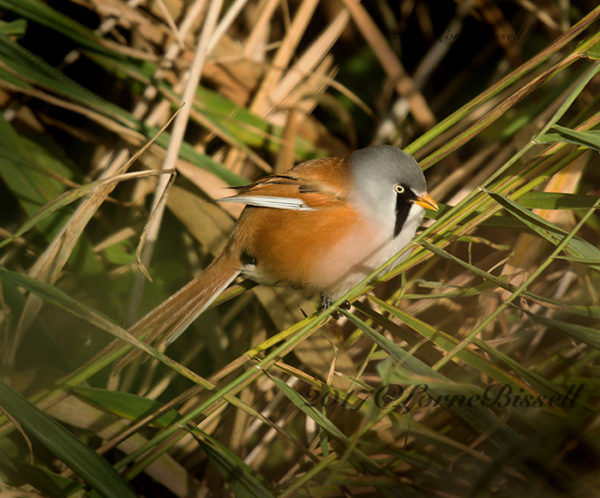
Bearded Tit (male), Longham Lakes, Dorset 25.10.2017 (Lorne Bissell).
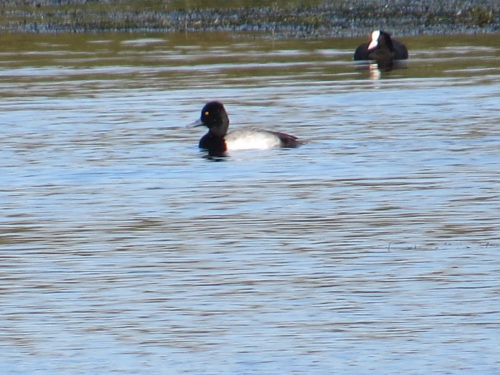
Lesser Scaup (male), Longham Lakes, 25/10/2017 (Roger Peart)
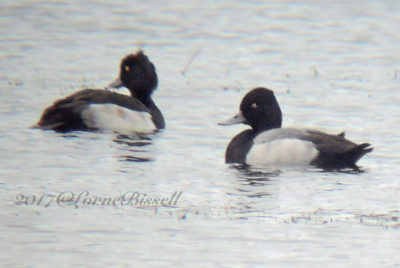
Drake Tufted Duck and Lesser Scaup, Longham Lakes 23/10/2017 (Lorne Bissell).
24th October
Bless its heart, the Lesser Scaup remained on site today, much to the relief of your correspondent. By all accounts, it was again much visited, despite the often appalling, damp weather. Interestingly, it seems to dive incessantly, perhaps more often than the accompanying Tufteds. It is now at the south end of the large (South) lake. Also today 2 Dunlin flew over and there was a Swallow near Longham Bridge (Dominic Couzens.)
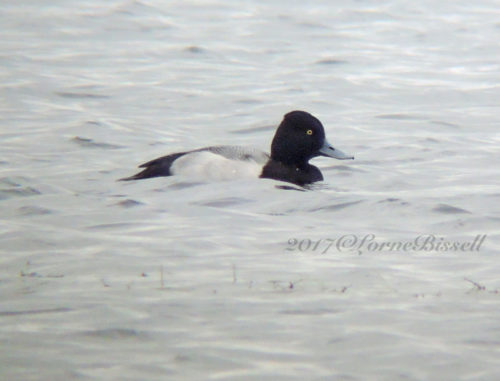
Lesser Scaup (male), Longham Lakes, Dorset 23/10/2017 (Lorne Bissell)
23rd October
Well, this is getting ridiculous. A combi-nation of a visiting Ian Lewis and Longham’s own George Green managed to find and identify a LESSER SCAUP on the North Lake today. After what has been a magical year and a fabulous autumn, this American vagrant is now Longham’s rarest bird. It soon attracted a stream of admirers, while this blog author was on a family break to Devon. Happily this species has a reputation for staying put. By the way, this brings the site total to 186. Ian Lewis also saw the season’s first Firecrest along Green Lane.
22nd October
George Green had a brief encounter with the Bearded Tits this morning. Meanwhile, Martin Wood connected with his first Yellow-browed Warbler in the afternoon, making it a red-letter day for him, although amazingly these birds are nowadays expected fare here – it was at least the 4th this autumn. It was in a flock of Long-tailed Tits in the south-west corner, near Samuel’s Wood.
20th October
Got another Longham tick this pm. Not a bird, but my first Longham Otter. It was just south of the island at the top of the South Lake. Initially it flushed all the gulls and ducks on the floating weed, it then swam directly towards the west bank and disappeared into the marginal vegetation (George Green.) Meanwhile, early in the morning one Great White Egret flew over Longham heading east. There was also one 1 Mediterranean Gull (first of the Autumn) 3 Swallows and 50 Lapwings, plus a brief call from a Bearded Tit (Lorne Bissell.)
18th October
A dog walker saw a dog Otter in river by Hampreston fields today. There was one Redshank on the weed in the middle of south lake, plus 2 Swallows and a Common Gull (Lorne Bissell.)
17th October
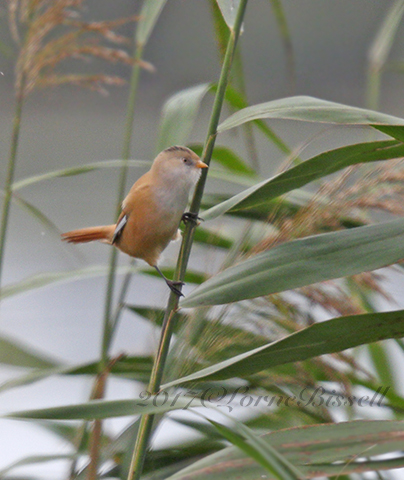
Bearded Tit (female), Longham Lakes, 17/10/2017 (Lorne Bissell)
Yet more excitement today appeared in the form of Longham’s third record of Bearded Tit. Two birds were located in the reeds on the east side of the South Lake, and appeared fitfully until at least lunchtime (Matt, Lorne Bissell). It really has been an amazing year. During a pretty “birdy” morning, there was a reasonable selection of other stuff. Two Coal Tits were in the south-west corner near Samuel’s Wood in mid-morning; these are still rare here and it is the first time we have recorded two together. Other birds in that area included Bullfinches, at least 2 Siskins, 3 Redwings and a smattering of over-flying Skylarks. There were also good numbers of Goldfinches, Greenfinches and Reed Buntings in this area of the site (Dominic Couzens).
16th October
It was always going to be a surreal day with ex-Hurricane Ophelia turning the skies dark and the sun red. And whether it was weird conditions or normal October milling around, yet another great bird turned up on-site today. Hot on the heels of his Common Scoter flock at the weekend, Lorne Bissell managed to unearth another seaduck early this morning, this time a male VELVET SCOTER – another first for the site, too. Unfortunately there was to be no repeat of last week’s twitch. The bird flew off by first light and wasn’t seen again. Apart from this the birding was actually rather meagre, although the first Redwings of the autumn, 12 of them, flew over.
12th October
Thought I would try for some visible migration today, especially after the high winds of the last few days. Although stuff was hardly streaming over, there were a few goodies: a party of 6 Skylarks over at 11.00am were, amazingly, the first of the year. There were also a couple of Siskins, at least 40 Linnets, 8 Reed Buntings and, flying hither and thither and not necessarily moving, were Goldfinches and a couple of Chaffinches. To complete a “finchey” hour there were also 3 Bullfinches in the south-west corner, alongside Samuel’s Wood, and the odd Greenfinch about. Of moderate interest was a Grey Wagtail, and the usual ducks. 40 species wasn’t bad for a single hour (Dominic Couzens.)
11th October
A Water Rail was heard this morning among the commoner birds (Dave and Pat Harris.)
8th October
A couple of Siskin flew over today, reportedly.
7th October
It was a great day for birding at Longham Lakes, with lots of excellent birds present. Pride of place goes to the group of 4 COMMON SCOTERS found in the early morning by Lorne Bissell, which had gathered a small band of admirers before 9.30am. This is a new species for the site, but it wasn’t the only highlight. George Green found the 6th Merlin for Longham, a male, and also
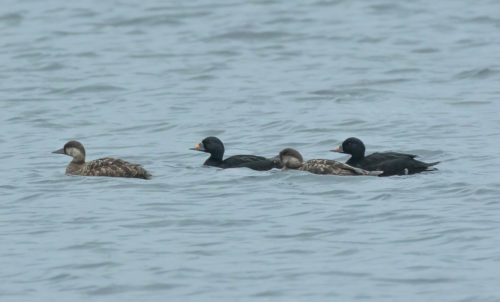
Common Scoters, Longham Lakes, 07/10/2017 (Darran Jones)
saw Peregrine, these two among a very impressive total of 53 species seen by him. There was also a Yellow-browed Warbler in the western corner of the Causeway again, while on the weed was a Ringed Plover among the 62 Lapwings. While it is easy to overlook commoner birds, Trevor Thorpe’s WEBS count of 656 Coots massively beats all other previous totals; there were also 114 Gadwall. Other more routine fare included 25 Greylag Geese, a Great Black-backed Gull, a small passage movement of Swallows, Pied Wagtails, Meadow Pipits, Reed Buntings and Linnets. A Stoat seen by Trevor was also highly notable, the first for a number of years, while there is also visible Mole activity by the Study Centre.
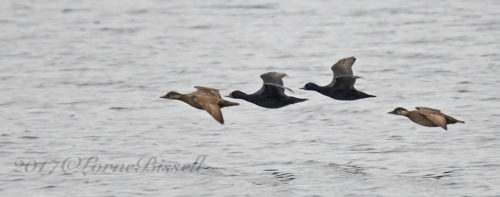
Common Scoters, Longham Lakes 07/10/2017 (Lorne Bissell)
6th October
There was a Yellow-browed Warbler along the Causeway today (Matt). 63 Lapwings out on the mat of weed, with a good number of Wigeon and Shoveler. Plenty of Chiffchaff moving about but the best two birds were Kingfisher on North Lake and a Sparrowhawk flying across Hampreston Fields towards Green Lane (Martin Wood.)
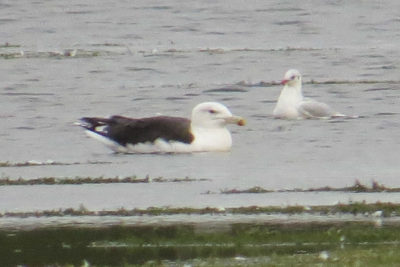
Great Black-backed Gull, Longham Lakes 07/10/2017 (Roger Peart)
4th October
In the early morning 2 Green Sandpipers were chasing around North Island and there was 1 Snipe, 1 Kingfisher, 1 Kestrel, 1 Sparrowhawk and 1 Swallow (Lorne Bissell). Later on the Cattle Egret returned and there were 64 Lapwings resting on the weed (George Green.) During a brief ringing session 1520-1700 there were just 10 new birds – 7 Chiffchaffs and 3 Goldcrests, the latter all 1st-year males (Roger Peart.)
3rd October
2 male Nathusius’s Pipistrelle bats were caught at Longham Bridge in the evening (Jan Freeborn.)
30th September
The Longham Lakes Open Day was a great event for all concerned – all the clubs associated with the Lakes, which are now run by the South-west Lakes Trust. Many thanks to all of you who attended, and thanks particular to George Green and Martin Wood for giving up their entire day to help. As it turned out, the birds themselves provided the chief objects of gratitude, not least a CATTLE EGRET which was only the third for the site (the second was last week) and provided decent, if distant views to most visitors. The eclectic supporting cast included lots of wildfowl, a Peregrine, showy Green Woodpeckers and a few Swallows.
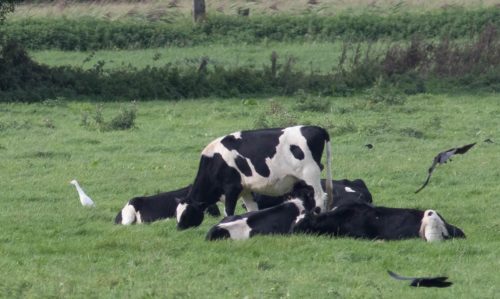
Cattle Egret (on left of cattle), Longham Lakes, 30/09/2017 (Darran Jones).
26th September
Lots of variety around today, although no rarities. The most prominent highlight was an impressive increase in the number of wildfowl, with maximum counts of 59 Wigeon, 22 Shoveler and 10 Teal, along with many Gadwall, making it feel like winter. Another highlight was the presence of no less than 5 Ruffs flying around the site this morning, a record count for here, and in company with 18 Lapwings. Visible migration amounted to little, with a small number of Meadow Pipits, Swallows and House Martins; a flock of 40 or so Goldfinches was also about. Other oddments included a Stonechat, a Goldcrest, a Peregrine, a Snipe and the two first-year Moorhens (Dominic Couzens, Martin Wood).
25th September
Remarkably, YELLOW-BROWED WARBLER is now annual at Longham and the “first” definite record of the season was seen and heard today in the south-east corner of South Lake behind the bungalows, in the scrub. There were also 2 Ruff on the weed, but no sign of any Cattle Egrets (Lorne Bissell).
24th September
A pair of CATTLE EGRETS visited the weed briefly this morning (KD Johnson.) This is only the second record for the site (although others look likely this winter).
20th September
A busy day on-site. Firstly, Roger Peart had a short afternoon ringing session and caught new birds in the form of 26 Chiffchaffs, 3 Blackcaps and 1 Goldcrest. There were als0 two re-trap Long-tailed Tits, one ringed in July this year the other in June 2015.
Meanwhile, Martin Wood found 2 Stonechats on Hampreston Fields, 1 Common Sandpiper still on the island; Ruff out on the mat of weed with the Lapwings . 1 Wheatear was a bonus, and still some Swallows, House Martin, 2 Reed Warblers and a Sedge Warbler. George Green counted the wildfowl and scored Gadwall at 100+, Wigeon 19 and Shoveler 16, all good counts for the time of year.
19th September
Had another evenings walk round South Lake. The Ruff were still out on the mat of weed with the Lapwings, and 1 Common Sandpiper was on the island. A number of Chiffchaffs moved along the willows, while a large group of Swallows came in from the north. Besides the Gadwall and a few Shoveler, it was Coot city (Martin Wood).
17th September
Dropped in to Longham this evening: still lots of House Martin and some Swallows over the lake. Scanned the mat of weed the normal number of 21 Lapwing and with a juvenile/female type Ruff. It was nice to watch C80 what I believe were Greylag Geese fly in from the North and over the two lakes going South (Martin Wood).
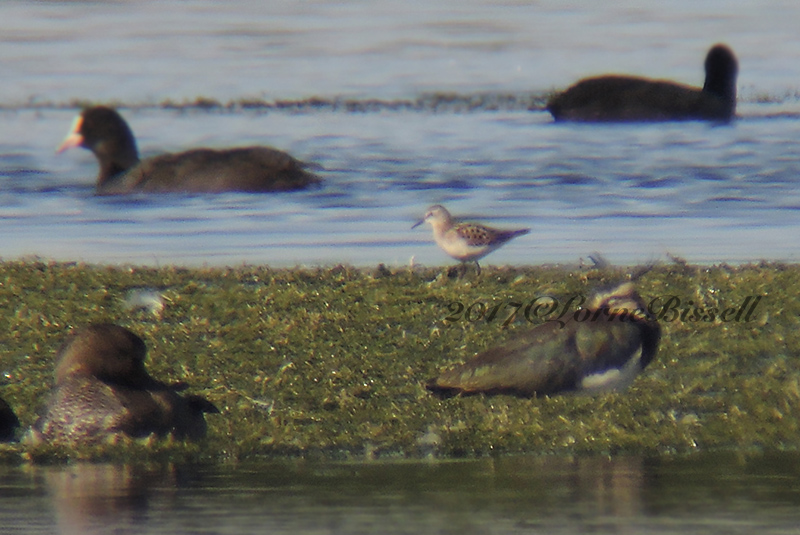
Little Stint (juvenille), Longham Lakes, 15/09/2017 (Lorne Bissell).
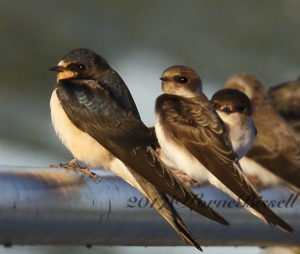
Swallows and Martins, Longham Lakes 15/09/2017 (Lorne Bissell).
15th September
Today’s surprise in a memorable year came in the form of a very small wader on the floating weed. Despite the remarkable run of American waders that have graced Dorset this week, this one proved to be nothing more than a well marked juvenile Little Stint. Even so, it was a fantastic bird, and only the second after one in November and December last year. The supporting cast included enormous numbers of Hirundines, many of which were migrating very high overhead, together with a couple of Sparrowhawks, a late-ish Willow Warbler calling and a number of Meadow Pipits over west, including, coincidentally, two flocks of 16 birds (George Green, Lorne Bissell, Dominic Couzens, Marcus Lawson et al.)
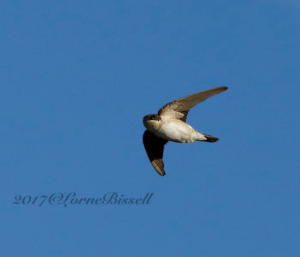
House Martin (juvenile), Longham Lakes, 13/09/2017 (Lorne Bissell).
14th September
A very brief ringing spell in windy conditions produced 3 Blackcaps, 2 Chiffchaffs and a Robin (Roger Peart.)
13th September
To the disappointment of its potential suitors, the Grey Phalarope was gone this morning. Instead, the lake scene was one again dominated by aerial birds. Yet again there was a late Swift. This year has already beaten the previous latest record for Longham (8th Sept 2011). The rest of the birds – probably at least 1000 of them, were House Martins and Sand Martins (maybe 3:1), with very few Swallows at all. Otherwise, there was a Hobby around, a Snipe was on the island, the 4 Garganeys were found in the afternoon, there were at least 7 Shovelers and the usually gathering of weed-loving ducks, Coots and grebes. There were also still a few Reed Warblers about (Dominic Couzens, Martin Wood.)
I happened to scrutinise the Black-headed Gull flock on the weed this morning, scanning for something phalarope-like. Instead I noticed that, among the 131 individuals, they were all adults except for a single first-winter. Odd.
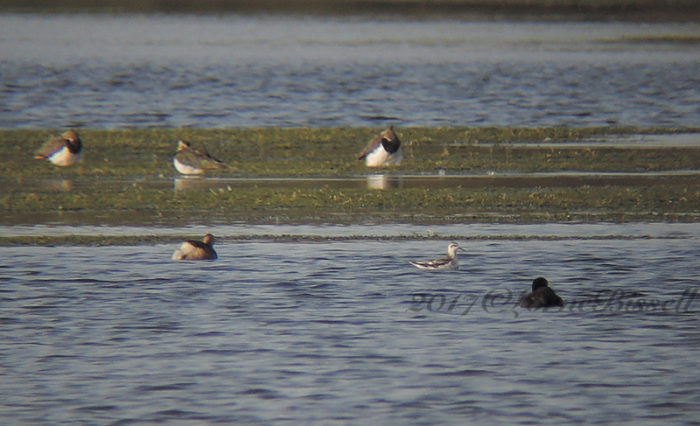
Grey Phalarope, Longham Lakes, 12/09/2017 (Lorne Bissell).
12th September
Longham’s remarkable year continues, this time with a GREY PHALAROPE on the South Lake (see above). Other goodies today included Ringed Plover, the 4 Garganeys, a Common Sandpiper , Hobby and a Swift (Lorne Bissell). The Phalarope is the second Longham record, the first being on 3rd September 2009.
9th September
The long staying 4 Garganey still present on the South Lake. In addition there was a large arrival of Willow/chiffs with at least 30 possibly 50 or more in among a large flock of small birds moving through the woods in the south-west corner of the site. This flock also included 2+ Spotted Flycatchers which is a scarce species at Longham. Finally a late Swift was present among large numbers of hirundines (George Green.) The flycatcher was Martin Wood’s 100th species at Longham this year. He also saw a Jay, and a Moorhen with 2 chicks on the pools to the south of the South Lake.
7th September
There were plenty of birds on-site today (I saw 56 species) but very few landbird migrants (apart from Hirundines) and little special on offer. That said, the 2 female-type Garganeys remain and are always a good birds to see. A Hobby made an appearance long enough to catch a Swallow and carry it off south, while there was also a Peregrine, and a Black-tailed Godwit flew over. There were a few Chiffchaffs and Blackcaps, and the odd Sedge Warbler. There was, in a sense, a remarkable changing of the guard as far as aerial birds were concerned; while Sand Martins were dominant a few days ago, today the House Martins took over, greatly outnumbering their smaller relatives. For probably the last time this year, the aerial bird tally was completed, by the appearance of a single Swift. One of the more interesting other observations was a Moorhen chick on the Stour, as this species is not recorded breeding every year. Other bits and bobs included the first 4 Meadow Pipits of the autumn, at least 3 Grey Wagtails, a Teal and a few Shovelers (Dominic Couzens).
6th September
Quick look at Longham Lakes late pm produced the 4 Garganey showing well on the South Lake and a Wheatear (George Green). Meanwhile, an evening ringing session produced 28 Chiffchaffs, just one adult among them, 3 Blackcaps, 2 Goldcrests, 2 Blue Tits and one juvenile male Bullfinch, moulting into his pink breast. Also two retraps – a juvenile Chiffchaff first ringed in early July, so presumably one local bird still hanging around. The other was more interesting – an adult male Great Tit, which I had first ringed at Canford as a nestling in a brood of 5 in May last year. Good to see that he is doing well. Details below (Roger Peart).
Great Tit
TX57681 Nestling 20/05/16 Canford Park, Wimborne,
Recaptured 06/09/17 Longham Lakes, Dorset (3 km SE, 1 year 109 days)
5th September
A morning visit revealed large numbers of Hirundines flying low over the lakes, and perhaps surprisingly these were heavily dominated by Sand Martins, which are often tailing off by now. As ever they were all but impossible to count, but a tentative estimate of 350 birds is undoubtedly many fewer than were actually there. This, though, is the highest count ever on site, beating an estimate of 300 in bad weather in March 2010. There were also some Swallows and a handful of House Martins. Perhaps not surprisingly, a Hobby flew over. The Garganey total is back up to 4, along with a few Shovelers and very strong numbers of Gadwall. There was only a scattering of other migrants, including singles of both Reed and Sedge Warbler (Dominic Couzens).
4th September
Just two Garganey present. Otherwise little of note, but still good numbers of Gadwall (72+) and Little Grebe (50+) (George Green).
2nd September
A better than average visit this morning with 3 Garganey, juvenile Ruff still on floating weed with 3 Black-tailed Godwit and 22 Lapwing, and a Hobby briefly flying over Hampreston Meadows. Also good numbers of Little Grebe (44+) and Gadwall (43+ on North Lake+ others on south Lake). (George Green.) There were also notable numbers of Sand Martins about, with a minimum of 20, plus a few Shoveler and 2 Teal (Dominic Couzens.)
1st September
Three Garganey still present. They were mobile this pm being seen both on the South Lake and North Lake. Ringed Plover and Ruff reported on the floating weed this am. The Ruff was still present this pm but no sign of the Ringed Plover (George Green).
